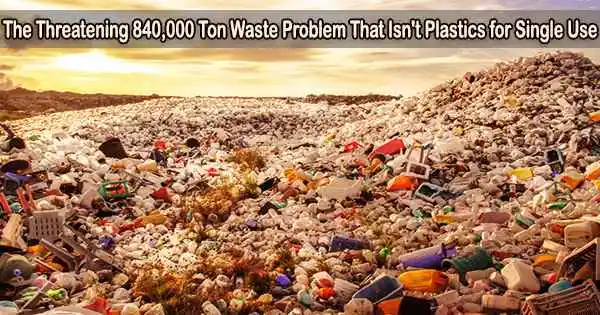Carbon and glass fiber composites (CFRP), materials frequently found in wind turbine blades, hydrogen tanks, airplanes, yachts, construction, and automobile manufacture, are predicted to become a significant waste stream globally by 2030.
If appropriate recycling techniques are not employed, the annual accumulation of CFRP trash from the aircraft and wind turbine industries alone is estimated to reach 840,300 tonnes by 2050, the equivalent of 34 complete stadiums.
Although there are recycling options, the majority of this garbage is currently disposed of in landfills or burned. Additional environmental effects from the creation of ‘virgin’ composites include resource depletion and high energy consumption.
This is true despite the fact that there are several ways to recycle carbon fiber composites, which, according to a research team from the University of Sydney, have the potential to drastically reduce energy use by 70% and prevent important streams of materials from going to waste if completely implemented.
“Carbon fibre composites are considered a ‘wonder’ material they are durable, resistant to weathering, and highly versatile so much so that their use is projected to increase by at least 60 percent in the next decade alone,” said Dr. Hadigheh from the School of Civil Engineering. “But this huge growth also brings a huge increase in waste. For instance, it’s been estimated that around 500,000 tonnes of carbon and glass fibre composite waste from the renewable energy sector will exist by 2030.”
A new recycling method
To tackle this issue, Dr. Hadigheh and his recent PhD graduate Dr. Yaning Wei have developed a new recycling method for carbon and glass fibre composites in a bid to prevent from end-of-generation materials going to landfill. Published in Composites Part B: Engineering their approach ensures increased material recovery and improved energy efficiency compared to previous methods.
This is a huge opportunity. And not only because various modes of recycling are cost-effective and minimally impactful on the environment. In an era of mounting supply chain disruptions, local recycled products can provide a more immediate product when compared to imports and create a burgeoning advanced manufacturing industry. While awareness of everyday consumer recycling is increasing and plastic waste is in the spotlight, Australia must urgently consider wide-scale recycling of new-generation construction materials before they mount up as another waste problem and are put into the ‘too hard basket’.
Dr. Yaning Wei
“Our kinetic analysis revealed that pre-treated CFRP undergoes an additional reaction stage, enabling enhanced breakdown at lower temperatures compared to untreated CFRP,” said Dr. Hadigheh. “The solvolysis pre-treatment not only facilitates greater breakdown but also preserves the mechanical properties of fibres by reducing heat consumption during recycling.”
The strength of recycled fibers made from pre-treated CFRP was up to 90% higher than that of fibers recovered from thermal degradation alone, outperforming it by 10%.
“To demonstrate the real-world applicability of our method, we successfully recycled part of a bicycle frame and airplane scraps made of CFRP composites using our hybrid approach. These results not only validate the effectiveness of chemical pre-treatment but also demonstrate the improved mechanical characteristics of the recycled carbon fibres,” said Dr. Hadigheh.
Reclaiming carbon fibre
The team also provided a thorough analysis of 10 various carbon and glass fiber composite waste treatment systems in a previous publication, taking into account the type of waste material and its geographic location as well as economic effectiveness and environmental implications.
Dr. Hadigheh’s team found that solvolysis a method whereby materials can be broken down with an application of solvent under a specific pressure and temperature could reclaim carbon fibre while delivering a high net profit. Catalytic pyrolysis and pyrolysis in combination with oxidation were two thermal recycling techniques that also offered a high economic return.
Additionally, it has been demonstrated that compared to incineration and landfilling, solvolysis and electrochemical techniques result in significantly lower CO2 emissions into the environment.
A huge opportunity
The researchers said that manufacturers should look beyond continuously creating virgin material and, in parallel, develop recycled products from end-of-life streams.
“This is a huge opportunity,” said Dr. Wei. “And not only because various modes of recycling are cost-effective and minimally impactful on the environment. In an era of mounting supply chain disruptions, local recycled products can provide a more immediate product when compared to imports and create a burgeoning advanced manufacturing industry.”
“While awareness of everyday consumer recycling is increasing and plastic waste is in the spotlight, Australia must urgently consider wide-scale recycling of new generation construction materials before they mount up as another waste problem and are put into the ‘too hard basket’.”
Dr. Hadigheh’s team is also developing methods for the recycling of composite materials and recently patented a machine to precisely align recycled carbon fibres, so that they can be repurposed.
About the analysis
The researchers conducted life cycle analysis (LCA), cost benefit analysis (CBA) and technology readiness level (TRL) assessments of the different waste treatment methods: landfill, incineration, mechanical recycling, catalytic pyrolysis, oxidation, pyrolysis combined with oxidation, fluidised bed, solvolysis using alkali and acid solvents, and electrochemical methods.





